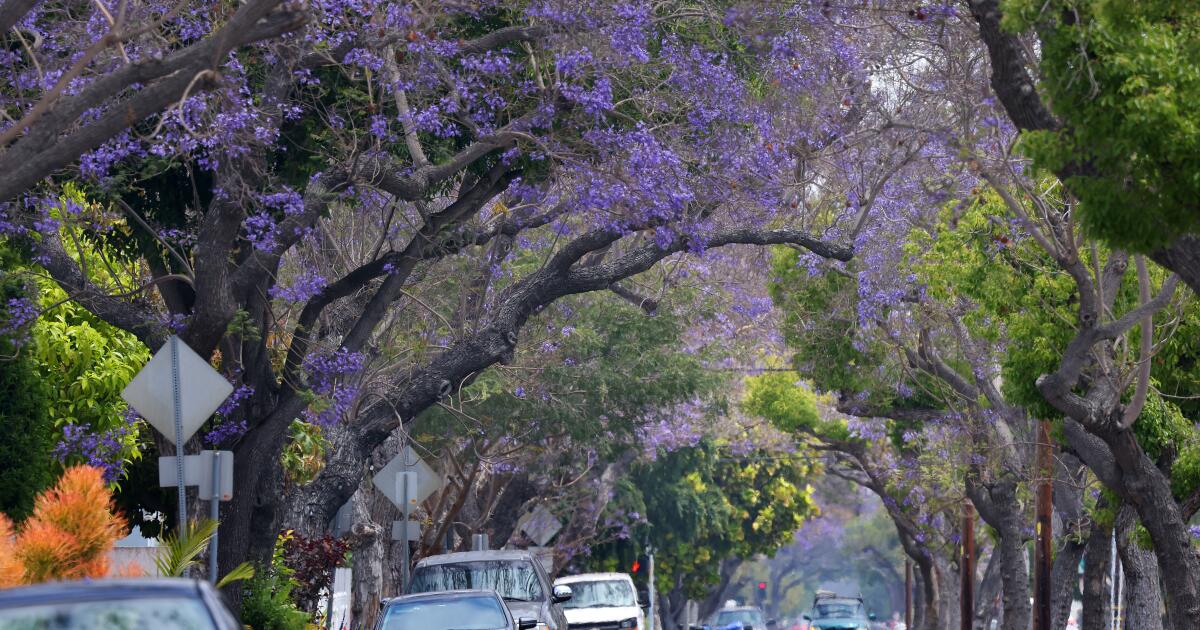What would Los Angeles be like without the roughly 30,000 jacaranda trees that line the city’s streets?
That depends on who you ask.
“This tree represents the worst of California: all glitz and no substance, leaving the cleanup to others and inspiring a thousand delusions and excuses,” The Times’ Gustavo Arellano wrote in a 2022 column, “Why We Hate Jacarandas.” Evan Meyer, executive director of the Theodore Payne Wildflower and Native Plant Foundation, noted last year that trees like the jacaranda, which are native to Brazil, Argentina and Bolivia, aren’t beneficial to Los Angeles wildlife.
Despite being an invasive species and its irritating tendency to cover cars and sidewalks with slippery, aphid-attracting blossoms, jacarandas have their fans, especially now when streets, freeways and medians are ablaze with the blue-purple blossoms. There are more than 58,000 jacaranda trees throughout Los Angeles and Orange counties.
Laura Hall, an urban forester for the city of San Marino, says there are about 270 jacaranda trees, with two more recently planted. She says residents generally love them; they’re so popular that when she asks for input on replacing dead or damaged trees, residents often choose jacarandas. “Our residents prefer flowering trees to non-flowering ones,” she says. Jacarandas are “second in popularity to ginkgo trees, which turn gold in the fall.”
Pasadena is home to about 2,000 jacaranda trees (Jacaranda mimosifolia). The tree’s popularity likely spread throughout Southern California, including Pasadena, says Michael King, the city’s forestry program coordinator. “Other gardeners and landowners liked the purple flowers and the tree’s adaptability to the local climate.” A 1940 list of the city’s official street trees, published by the city parks department, lists jacaranda trees as the official street trees of Del Monte and Paloma streets.
Jacaranda trees are a love-it-or-hate-it tree, but one advantage they have is that they’re more resilient than most tree species, says Lisa Smith, a certified master arborist and tree instructor with the UCLA Extension Landscape Architecture Program.
“The city of Los Angeles would be severely lacking in tree canopy if we had a lot of invasive species,” she says. “Planting native species is always great, but to increase the urban tree canopy, we need to increase species diversity, and we can do that by utilizing climate-tolerant species.”
As for density, Smith believes some areas of Southern California, like Pasadena, are denser because the trees thrive in hotter climates: “This species is more prevalent in the warmer inland parts of the city,” she says.
Smith gives the example of a jacaranda tree planted in the median strip along Wilshire Boulevard near the West Los Angeles VA Medical Center. “It was planted for the Democratic Convention over 10 years ago,” he says. Today, the tree is “swaying and thriving in a windy, harsh, heat-island environment.”
Growing 25 to 40 feet tall and just as wide, the flowering tree became popular in Los Angeles in the 1920s and 1930s thanks to the efforts of botanist Kate Sessions, who introduced more than 100 species of flowers to San Diego in 1892.
Jacaranda trees usually flower by June, but they can bloom any time of the year, depending on light, heat, rain, and pruning conditions.
If you’re wondering where you can find jacarandas in Los Angeles and Orange County, The Times has compiled all the publicly available tree data we could find. Jacaranda-rich areas include Santa Ana (about 4,200 trees), Anaheim (2,000), Pasadena, Santa Monica (1,050 trees) and Mid-Wilshire (940 trees). Areas with the most jacaranda trees per square mile include West Hollywood (1,400 trees), West Los Angeles (639 trees) and Beverly Grove (720 trees).
Here are some specific streets where you can find jacarandas: In Pasadena, Forester King recommends East Del Mar Boulevard (from Arroyo Parkway to Lake Avenue), Del Monte Street (from North Arroyo Boulevard to Lincoln Avenue), and Paloma Street (from Allen Avenue to Altadena Drive). In San Marino, Hall recommends Monterey Road (from Garfield Avenue to Old Mill Road).
According to the mapping data, other streets lined with jacarandas include Oakhurst and Palm Streets in Beverly Grove (from Barton Way to Santa Monica Boulevard), Palm and Alta Streets in Beverly Hills (from Santa Monica Boulevard to Sunset Avenue), the intersection of Poinsettia Place, Santa Monica Boulevard and Fairfax Avenue in West Hollywood, Whittier Drive along Holmby Park just outside Westwood, and South Guernsey Street in Santa Ana (from West McFadden Boulevard to West Wilshire Boulevard).
—Brittany Levin Beckman contributed to this report

